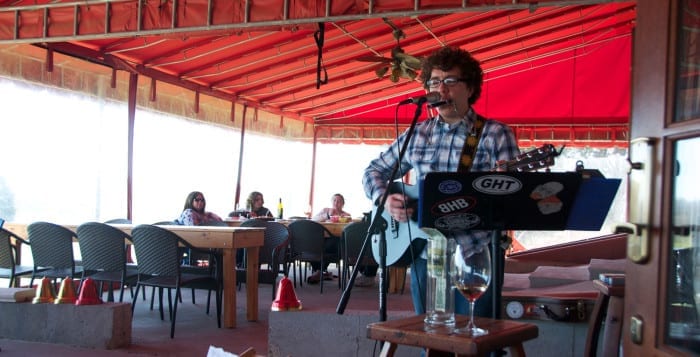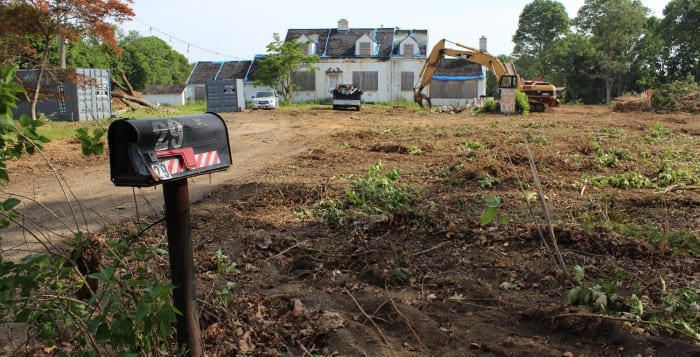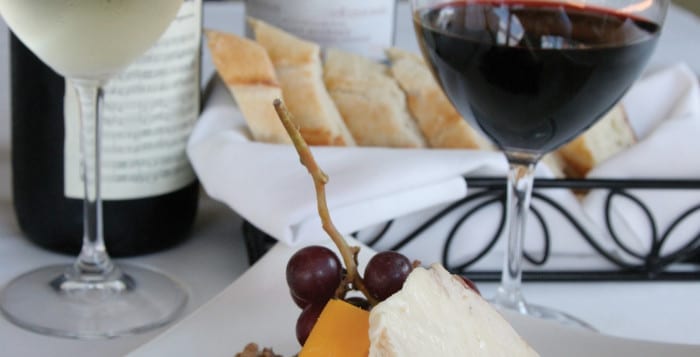By Chris Mellides
Beyond a gravel-strewn parking lot, a weathervane perched atop a rustic old potato barn stands tall and shines in the warmth of the weekend sun at Clovis Point winery and vineyard.
The neatly trimmed lawn below is home to a number of red tables and chairs that are occupied by families whose children play on the green grass beside the expansive grapevines that stretch for yards.
With the sunlight gleaming on high, I wipe the sweat from my forehead and casually pull down the brim of my hat to allow my eyes to adjust to the brightness of the outdoors. A gray oak barrel once used to age red wine now serves as a makeshift table and a temporary resting place for my camera equipment.
I pull a barstool close to the aged barrel and wait patiently to meet Kelly Bruer, Clovis Point’s general manager, for a chat and a tour of the facilities.
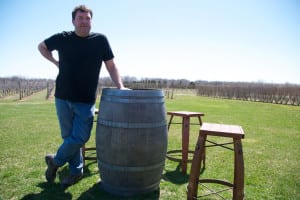
Bruer makes his way from the tasting room nestled inside the 150-year-old building. As I stand to face him, he greets me with a smile and a firm handshake. He asks me if I’m a wine enthusiast, but to his surprise, I tell him that I’d much rather prefer a stout beer or a frothy IPA.
“Sit down, sit down. Be relaxed, it’s a winery,” says Bruer. “Do you want some wine?”
“No, thank you, but I appreciate the offer.”
“Are you sure?” he asks. “I’ve got a nice, light wine that’s good to introduce beer drinkers to.”
After some more convincing I finally accept, and Bruer arranges for a glass of white wine to be brought to the table. At first sip, the effervescent blend tastes crisp with clean fruity notes, rounding out an overall full-bodied flavor.
“The wine that you’re having there is fermented and then it goes to the bottle and it rests a bit; it’s kind of a seasonal wine and we do it every year,” says Bruer. “It’s crisp and it’s light and it’s chardonnay, and if I didn’t tell you it was chardonnay you probably wouldn’t know it.”
A high-ranking vineyard and winery located on the North Fork of Long Island, Clovis Point first opened its tasting room in 2007. Much of the walls and beams of the tasting room and surrounding property remain unchanged since the 1920s and were preserved during the eventual repurposing of the structure.
Long Island’s long, warm summers and cooling breezes permeating from the neighboring Long Island Sound and Atlantic Ocean make for the perfect maritime climate. And the glacial soils unique to the East End have allowed vineyards like Clovis Point and the other 56 Long Island winemakers to be the largest producers of European grapes in the Northeast, according to the Official Website of the Long Island Wine Council, www.liwines.com.
While the well-versed general manager of Clovis Point has held many titles in the past, including working as a journalist, a sous chef and a commercial lender, he admits to having always been drawn to the North Fork and its vineyards.“It can be a difficult balance for the musician and I do respect that, because I know it’s not just a matter of walking in the door and putting a guitar over your shoulder…these guys practice and
put time into it and that’s an important part for people to realize.” — Kelly Bruer, Clovis Point’s general manager
“I grew up here on the North Fork, and when I was 12 years old I started working at vineyards over the course of a few summers,” said Bruer. “I never thought I’d come back, but it’s exciting. I wake up in the morning and come to work, and I work in a beautiful vineyard.”
When he took the job as general manager in January of 2011, Bruer was thrust into taking on multiple roles, including a position in operations and in event planning.
Sharing similar responsibilities is Alicia Ekeler, the tasting room director at Lieb Cellars, another North Fork winery with a tasting room located on the estate. Like Bruer, the duties she undertakes can be tiring, but Ekeler believes those duties are rife with their own rewards.
“Three days of my workweek are spent planning all the tasting room events, managing the ongoing music schedule, staffing and scheduling,” says Ekeler. “On the weekends, I am in the tasting room making sure everything is operating smoothly and that our guests are leaving happy.”
And when her guests leave happy, Ekeler is happy. She says that she’s been in this role for just more than a year, but that she’s been with Lieb Cellars for almost two.
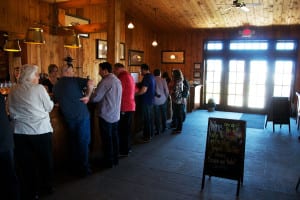
Something else that Bruer and Ekeler share outside of their study of the culinary arts is their enthusiasm towards working with local musicians and affording them the opportunity to perform at their respective vineyards.
When selecting artists to feature at Clovis Point’s tasting room events, Bruer says that while originality and playing skill are important, it is vital for scheduled performers to understand that their live music should only add to the warm atmosphere rather than become the main focus of the day’s event.
“Explaining the wine and introducing people to the wine, that’s the more important thing,” says Bruer. “It can be a difficult balance for the musician and I do respect that, because I know it’s not just a matter of walking in the door and putting a guitar over your shoulder … these guys practice and put time into it and that’s an important part for people to realize.”
No stranger to Long Island’s winery scene, local musician Bryan Gallo shuffles into Clovis Point’s tasting room patio and examines his playing space. While sipping wine from a tulip-shaped glass he turns to face his audience.
Donned in black horn-rimmed glasses and a plaid button-down shirt, Gallo cheerily greets the crowd at Clovis Point. The Suffolk County native has performed at the vineyard several times over the last three years, so for many of the vineyard’s guests, this wasn’t the first time they’ve been introduced to Gallo and his music.
After tuning his jet-black acoustic guitar, he begins to play original song selections from his 2014 full-length album titled “Party Guest.” Gallo’s playing style combines alternative country-rock with wistful pop music elements.
As he strums his guitar, he’ll occasionally pepper in a bluesy harmonica to accent some of his songs. A sheet music stand faces Gallo and just beyond it are CD copies of his first major album release, along with a mailing list and tip jar that rest on the floor by his feet.
Friends and family joined together to share in Sunday’s performance at Clovis Point. Among those in attendance were vineyard club member and Setauket resident Steven Krinsky.
“We’ve been members of Clovis Point for the past seven or eight years, and we love the wine, we love the owners, and we love the staff. It’s a perfect trifecta,” says Krinsky. “The live music just adds another dimension [and] I think Bryan’s music goes perfectly with the wine and the whole experience of being at a vineyard.”
At Lieb Cellars, live performances were first introduced in the winter of 2012 with the launching of the Friday Night Music Series. The series sticks to a rotating schedule featuring local musicians preforming a range of diverse genres from folk rock to opera sung in duet, according to Ekeler.“It’s a very artistic feel in that you have the chance to spread your wings and do what you need to do and the people at the wineries are incredibly responsive to it.” — Bryan Gallo, Musician
“We launched it as something for locals to do in the off-season; a chance for them to enjoy the space when it is not bursting at the seams as it tends to be in the high season,” says Ekeler. “We really try to explore different genres so that there is something for everyone every month, and it does not get repetitive.”
Like Clovis Point, Lieb Cellars receives many requests from musicians who are interested in performing at the winery, but those that are booked to play are often chosen because their playing styles are quieter and more relaxed to better suit the tasting room atmosphere.
For active musicians like Gallo, wineries are the perfect venue to learn how to engage with different kinds of audiences, while maintaining authenticity as an artist and receiving deserved compensation for live performances.
“I’ll always reach out to the wineries. Whether the [guests] plan on me being here or not, I feel like it’s always a really good synergistic relationship,” says Gallo. “People have picked up albums of mine because they’re interested, and they ask me ‘Well, when are you playing at Clovis again, or when are you playing at any of the wineries again?’ There’s a relationship there that just works.”
The unique relationship struck between musicians and the vineyards that embrace them is one that remains strong, and one that Gallo believes will endure well into the future.
“We don’t live in a small place, [Long Island] is a hundred plus miles back and forth from either end, so you can play a show out east and go out west the next day and you’re covering brand new ground,” says Gallo. “But out here, it’s just good. It’s a very artistic feel in that you have the chance to spread your wings and do what you need to do and the people at the wineries are incredibly responsive to it.”

